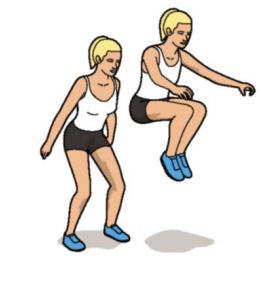
Check out this dynamic warm-up, which will get you prepped for any workout. For example, if you’re about to do 50 squat jumps, your warm-up should include some bodyweight squats and stretches for improved squat technique. Perform a 5-10 minute warm-up with dynamic stretches and movements that match the exercises in your plyometric workout. The result is increased calorie- and fat-burning, even after your workout is over. What you’re really doing here is asking your muscles and body to do more work than you can provide oxygen for. Consecutively fatiguing the same muscles can decrease your workout performance over the 20-min session (or much sooner) and lead to poor exercise form.ģ) Understand oxygen debt and EPOC (excess post-exercise oxygen consumption) 4. Performing plyometric exercises with poor technique is a great way to get injured.Ģ) Train different body parts in your circuit. Here are some important tips to keep in mind:ġ) Quality comes first! Within a few minutes you’ll be sucking wind, so mentally prepare and don’t let your exercise form suffer. A more advanced option is to superset heavier strength training exercises with plyometrics, as professional athletes are known to do. Plyometric exercises can be performed as a superset or in a circuit. With the right plyometric exercises you can simultaneously improve your weaknesses, increase your coordination and agility, build your power and cardiovascular endurance, and burn more fat as your fitness, recovery from training, and overall performance improve.

Plyometric exercises are a great addition to any comprehensive strength or wellness program because of the demands they place on your muscles and cardiovascular conditioning. 2Ĥ) They’re a fun and effective way to train like a professional athlete 1Ģ) They train your fast-twitch muscle fibers, which are responsible for speed and powerģ) Over time, plyometric exercises train your muscles to store more energy because they increase the number of mitochondria (the energy-producing powerhouses of your cells) in the trained muscle groups. Plyometrics are beneficial for many reasons:ġ) Because they induce oxygen debt (which means they cause you to feel muscular burn and fatigue, and make you to go breathless), there is high fat-burning potential. If you’re more advanced, you can challenge yourself with harder exercises like box jumps, plyometric push-ups, and burpee pull-ups. If you’re new to plyometric training, exercises like jumping rope, skipping, hurdling and jumping on low objects are great ways to get started.

Some examples of plyometric exercises are jumping rope, sprinting, throwing objects at fast velocities (think baseball, football, and Olympic throwing), and even punching or kicking like in martial arts.īefore ramping up the intensity of your workouts with plyometrics, it’s a good idea to check in with your doctor, or get evaluated by a physical therapist, or competent trainer. Simply stated, a plyometric exercise is a movement that is performed rapidly where there is a quick stretching or loading of the muscle followed by a forceful contraction. I’ve even included video clips of me demonstrating the exercises so you can see the proper form and technique.īut before we get into the workout, let’s first define what constitutes plyometric exercise. If you’re looking for an effective and safe plyometric workout that takes just 20-minutes, you will love the workouts I have for you below. When creating a plyometric workout, it’s important to keep in mind that plyometric exercises can be very effective, but they can also become dangerous, especially when stacked together with fatigue.

Through my experience, I’ve learned that not all plyometric exercises are effective, or even safe. As a competitive decathlete, I’ve completed tons of plyometric workouts and exercises.


 0 kommentar(er)
0 kommentar(er)
